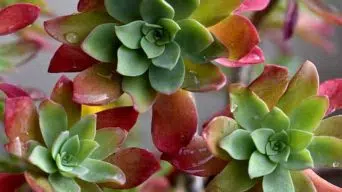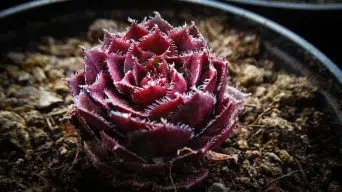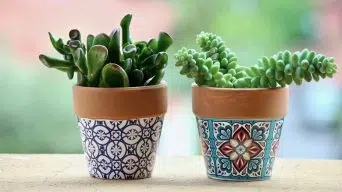Succulents are one of the most popular plants to have at home.
They are easy to care for, look great on a windowsill or outside and are an excellent choice for those who like to garden but may not have a green thumb.
Succulents do need water, but how can you know if your succulent needs water?
This article goes over how to tell if your succulent needs water so that you can make sure it stays healthy!
How Often Should You Water Succulents
To know when and how often you should water succulents, it is important to understand how and why they need water.
A succulent, as we know, is a plant with thick leaves or stems that store water to survive prolonged periods without any watering.
There are many different types of succulents found worldwide, but one thing remains true about them: they need very little water to survive.
They need to be watered when the soil is dry.
If you are not sure whether the soil is wet or dry, stick your finger into it about an inch deep and if it feels moist, then leave it be because succulents like to live in arid environments.
If, however, the top part of the soil is dry (usually between ½ – ¾ inches), water them.
In general, succulents need to be watered once a week. However, many things can affect this, such as the amount of light they receive and how thick their leaves or stems are.
Having said this, there can also be times of the year where they may need more or less water than usual, depending on if they’re in active growth (summer) or during dormancy (winter).
For example, during the growing season (summer), succulents need to be watered more often because sunlight will cause them to dry out faster.
On the other hand, during dormancy (winter), succulents need to be watered much less.
How Do I Know if My Succulent Needs Water?
Knowing when your succulent needs water or not is relatively easy; it’s how to tell if your succulent is under or overwatered that people find confusing.
To tell when your succulent requires water, all you need to do is check the soil and see if it’s dry or not.
If it is, give them some water; if not, don’t worry about giving them any water until next time.
However, it’s also important to know whether your succulent plant has been overwatered or underwatered to assess if it requires water.
Underwatered vs. Overwatered Succulent
When watering succulent plants, it is important to know how much water your succulent needs.
There are two conditions that indicate whether or not you should water your succulent: underwatered and overwatered plant.
What Does an Overwatered Succulent Look Like?
Overwatering occurs when your succulent soil is left overly damp for a long time.
Usually, this happens when you water your succulent before it has a chance to dry out fully.
When this happens, the excess moisture causes root rot and fungal diseases that will eventually kill your plant if not corrected quickly.
The first thing you’ll notice is a mushy stem or leaves at their bases.
If left unattended for too long, these plants will begin to turn yellow as they starve from a lack of chlorophyll-producing nutrients in the soil.
Another sign of overwatering is when the leaves turn black and begin to curl up. This is because the excess moisture causes rot to form in the stems, causing them to mold and die off.
If this goes untreated, all succulent’s roots will become overrun with fungus and die off completely.
What To Do if Your Succulent Is Overwatered?
If your succulent is overwatered, the first thing to do is discard its soil.
This will prevent any further root death from occurring. Then, place your plant in a well-ventilated area where it can dry out completely before being re-potted into fresh soil.
It’s also important that when watering your plants after this happens, you only do so when they are fully dried out and not damp at all anymore.
This means waiting long enough for water droplets to no longer appear on their leaves when held up against light streaming through a window or door frame.
Another way to determine if your succulent needs water is by feeling its weight. If it feels light, then chances are good it could use some water.
If it feels very heavy, then you should skip watering the plant. The soil is probably already wet and can’t take any more water without spilling out of the holes in your pot.
Ensure that when re-potting your plant into fresh soil after overwatering has occurred, you only use a cactus or succulent soil mix.
Do not use regular garden dirt because it contains too much clay content, which will cause them to stay soggy for more extended periods than needed.
Succulents prefer fast-draining soils, so their roots don’t sit in excess water for long periods at a time.
The last thing to remember is if you want your succulents to stay alive and healthy longer, try not to water them too often, as overwatering can kill any plant species no matter how hardy others consider them.
What Does an Underwatered Succulent Look Like
An underwatered succulent is the opposite of an overwatered one.
Usually, this happens when you water your plant less than it needs, which causes its soil to dry out too fast for them to take up enough moisture before it evaporates into thin air again.
Sometimes, this can be caused by placing them in an area exposed to too much heat.
When this happens, the plant’s soil will become extremely dry, and any leaves that were once plump with moisture will begin to wrinkle up like a raisin because it lacks water entirely.
Common signs of an underwatered succulent are leaves that become brown and crispy to the touch or plants whose stems begin turning a deep yellowish-brown color.
Another indicator is when you attempt to water your plant, but it has already dried out too much for any more moisture in its soil to be absorbed by it.
This usually results in water sitting on top of their soil instead of being taken up into it because there is nothing left present inside of them for this excess moisture to cling onto.
What To Do if Your Succulent Is Underwatered
If your succulent is suffering from insufficient watering, your first step should be to discard its current potting soil and use a different type of potting mix.
The best kind is the same as we mentioned above: a fast-draining succulent or cactus mix that won’t hold onto too much water either.
Then, give them at least one good soak in fresh water before placing their pots into direct sunlight, where they will receive bright light during daytime hours but no full sun exposure, which can cook them like food on a hot grill if given enough time.
Finally, remember never to let these plants dry out completely since this could kill any plant species regardless of how hardy they are considered.
Instead, only allow the topmost layer of soil to dry out before watering them again.
How to Water Your Succulents Properly
Watering your succulents properly can seem daunting at first, but it becomes easy to do once you know the basics.
Firstly, always remember that all species of succulents require fast-draining soils with excellent drainage holes to absorb water effectively when watered.
This means never planting them directly into standard garden dirt because this type of soil holds onto way too much moisture, which causes over-watering problems instead of preventing them from happening in the first place!
Secondly, make sure you only water your succulents when their topmost layer of soil has fully dried out, if not longer.
Finally, water your succulent enough that excess moisture runs out of the bottom of its pot and into the soil below, but never allow it to sit in this runoff for long because all you’re doing is essentially flushing away any nutrients they need.
And remember, if you want them to stay healthy longer, try not to water them too often as overwatering can kill any plant species no matter how hardy others consider them.
Final Thoughts
Succulents need water, but not too much. If you notice your plant has small wrinkled leaves and is shrinking, it needs more water.
On the other hand, if you notice that your succulent soil feels dry when touched or its stem appears to be shriveling up, it might be time for a new planter with fresh soil and less water.
Succulents need the perfect amount of water and sunlight to be healthy.
Pay attention to your succulent’s water requirements and provide just the right amount – not too much or too little. By following these guidelines, taking care of your succulents will be a straightforward task!







